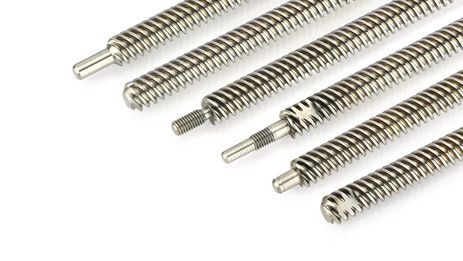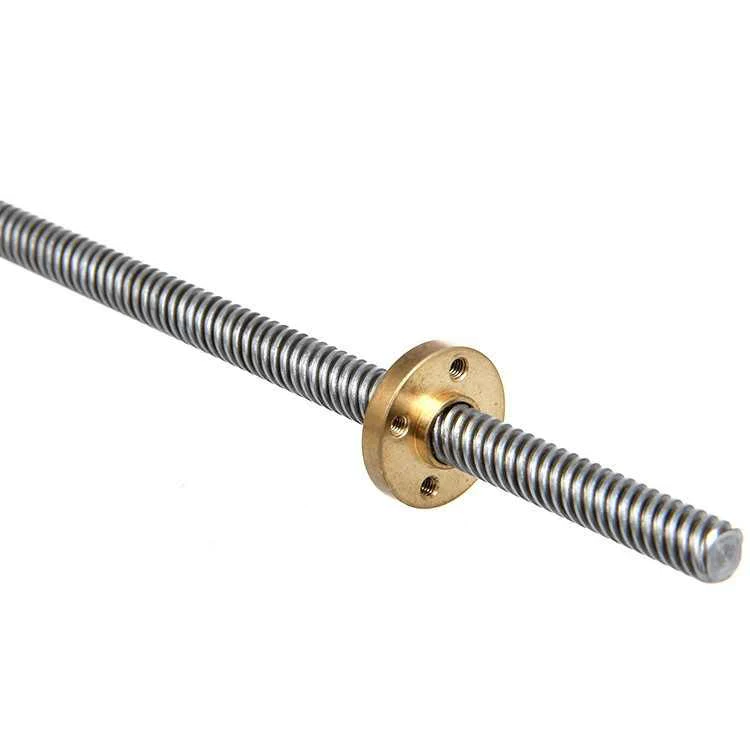Product Description
Product Description
| Brand | TOCO |
| Precision | C7&C5 rolled, C5&C3 grinding |
| Model | SFK,SFU,DFU,SFE,SFS,DFS,SFI,DFI,SCI |
| Size customize | Dia: 12,16,20,25,32,40,50,63,80mm| Lead: 5,6,8,10,16,20,25,32,40,80mm |
| Maximum length | 1000MM~7500MM,different diameter maximum length are different |
| HS CODE | 8483900090,8483457100 |
| Items packing | Plastic bag+Cartons Or Wooden Packing |
| Payment terms | T/T , Western Union |
| Production lead time | 5~7 days for sample , 15~30 days for the bulk |
| Ball Screw | Keyword |
| Application | CNC machines, Printing Machine ,Paper-processing machine Machine tool, Solar energy equipment, Medical equipment |
Company information:
HangZhou CHINAMFG Transmission Machinery Co., Ltd, is a specialized manufacturer in linear motion
products in China, which was established in 1999. Based on the strong technical strength, outstanding
quality, and high capacity, we have a good reputation both in China and abroad, and now we have many
customers all over the world. Our main products are ball screw, ball spline, linear guide, linear bearing,
mono stage, machine tool spindle, ball screw support unit, and locknut. You may find more information
on our website at www.toco.tw.
Marketing & Shipping:
1.Package: Carton or wooden case
2.Delivery time: 15 days after receiving the deposit
3.Shipping: by express (DHL, TNT, FedEx, etc.) or by sea
FAQ :
1. Service :
a. Help customers to choose the correct model, with CAD & PDF drawing for your reference.
b. Professional sales team, make your purchase smooth.
2.payment :
Sample order: We require 100% T/T in advance. sample express need request pay by clients
Bulk order: 30% T/T in advance, balance by T/T against copy of B/L.T/T, Paypal, Western Union is
acceptable.
3.Delivery :
sample: 5-10 business days after payment confirmed.
Bulk order:10-20 workdays after deposit received.
4. Guarantee Time
TOCO provides a one-year quality guarantee for the products from your purchase date, except for
the artificial damage.
5.After sale-Service
During the warranty period, any quality problem of the CHINAMFG product, once confirmed, we will
send a new 1 to replace.
/* January 22, 2571 19:08:37 */!function(){function s(e,r){var a,o={};try{e&&e.split(“,”).forEach(function(e,t){e&&(a=e.match(/(.*?):(.*)$/))&&1
| Precision: | C7 |
|---|---|
| Screw Diameter: | 31-40mm |
| Flange: | With Flange |
| Nut Number: | Single |
| Rows Number: | 4-Row |
| Nut Type: | Circulator |
| Samples: |
US$ 40/Piece
1 Piece(Min.Order) | |
|---|
| Customization: |
Available
|
|
|---|

How do lead screws contribute to the efficiency and accuracy of linear motion systems?
Lead screws play a crucial role in enhancing the efficiency and accuracy of linear motion systems. Here’s how they contribute to these aspects:
Efficiency:
Lead screws can contribute to the efficiency of linear motion systems in the following ways:
- Mechanical Efficiency: Lead screws can achieve high mechanical efficiency in converting rotary motion into linear motion. The efficiency depends on factors such as the thread design, lubrication, and preload. When properly designed and lubricated, lead screws can operate with minimal friction and energy loss, ensuring efficient power transmission. This efficiency allows for effective utilization of the input power and reduces energy consumption.
- Self-Locking Capability: Lead screws have a self-locking characteristic, which means they can hold their position without the need for additional locking mechanisms. The friction between the mating threads helps prevent back-driving and maintains the position of the load. This self-locking property eliminates the need for continuous power input to hold the position, improving overall efficiency.
- No Energy Consumption at Rest: When the lead screw is not in motion, it does not consume any energy. This is advantageous in applications where the load needs to be held in position for extended periods. The self-locking feature of lead screws ensures that the load remains stationary without energy input, contributing to energy efficiency.
Accuracy:
Lead screws contribute to the accuracy of linear motion systems in the following ways:
- Precise Positioning: Lead screws allow for precise positioning of components or loads. The thread pitch and design, combined with the rotational input, enable accurate and controlled linear movement. This precision is crucial in applications that require accurate alignment, spacing, or adjustment of components.
- Repeatability: Lead screws provide excellent repeatability in linear motion. Once a position is established, lead screws can reliably return to the same position repeatedly. This repeatability is critical in applications where consistent and repeatable motion is required, such as in CNC machines or automated systems.
- Low Backlash: Backlash refers to the axial movement or play between the screw and nut when changing direction. Lead screws can be designed to minimize backlash, resulting in more accurate positioning and reduced lost motion. Low backlash is particularly important in applications that demand precise positioning, such as machining operations or optical systems.
- Elimination of Drift: Lead screws help eliminate drift or movement over time. Once a position is set, the self-locking property of lead screws ensures that the load remains stationary without any gradual drift or positional changes. This stability is beneficial in applications where maintaining a fixed position is critical, such as in inspection systems or medical equipment.
Overall, lead screws provide efficient power transmission, self-locking capability, precise positioning, repeatability, and low backlash, all of which contribute to the efficiency and accuracy of linear motion systems. These characteristics make lead screws suitable for a wide range of applications where controlled and reliable linear motion is required.

Can you provide insights into the importance of proper lead screw installation and alignment?
Proper lead screw installation and alignment are crucial for ensuring the optimal performance, longevity, and reliability of lead screw systems. The installation and alignment process directly affects the system’s accuracy, efficiency, and overall functionality. Here are some key insights into the importance of proper lead screw installation and alignment:
- Accuracy and Precision: Proper installation and alignment are essential for achieving accurate and precise linear motion. Misalignment or incorrect installation can introduce angular errors, axial misalignment, or parallelism issues, leading to positioning errors and reduced system accuracy. By following the manufacturer’s guidelines and using appropriate alignment tools, the lead screw can be installed in a way that minimizes misalignment and ensures precise movement and positioning.
- Load Distribution: Correct alignment during installation helps distribute the load evenly along the length of the lead screw. Proper alignment ensures that the load is shared uniformly between the screw and the nut, preventing excessive stress on specific areas. Improved load distribution reduces the risk of premature wear, deformation, or failure of the lead screw and enhances the overall durability and load-carrying capacity of the system.
- Backlash and Efficiency: Proper installation and alignment contribute to minimizing backlash in lead screw systems. Backlash, which refers to the clearance between the screw and nut, can negatively impact system performance, precision, and efficiency. Misalignment can exacerbate backlash issues, resulting in reduced repeatability and accuracy. By aligning the lead screw correctly, the backlash can be minimized, improving system efficiency and eliminating potential sources of error.
- Reduced Friction and Wear: Accurate installation and alignment help reduce friction and wear between the lead screw and nut. Misalignment can cause the screw and nut to rub against each other unevenly, leading to increased friction, accelerated wear, and reduced system lifespan. Proper alignment ensures that the mating surfaces are in optimal contact, minimizing friction and wear, and improving the overall efficiency and longevity of the lead screw system.
- System Stability and Vibration: Proper installation and alignment contribute to system stability and reduced vibration. Misalignment can introduce vibrations, resonances, or oscillations in the lead screw system, affecting the overall performance and potentially causing excessive noise or system instability. By aligning the lead screw correctly, the system’s natural frequencies can be maintained within acceptable limits, improving stability, reducing vibrations, and enhancing the system’s overall operation.
- Maintenance and Service: Proper installation and alignment simplify maintenance and service procedures. When lead screws are installed and aligned accurately, routine maintenance tasks such as lubrication, inspection, or component replacement can be performed more efficiently. Access to critical components is improved, and troubleshooting potential issues becomes easier, reducing downtime and enhancing the overall serviceability of the lead screw system.
In conclusion, proper lead screw installation and alignment are of utmost importance for achieving optimal performance, accuracy, efficiency, and durability of lead screw systems. Accurate alignment minimizes positioning errors, improves load distribution, reduces backlash and friction, enhances system stability, and simplifies maintenance procedures. By following manufacturer guidelines and utilizing appropriate alignment techniques, the benefits of proper installation and alignment can be realized, ensuring the long-term reliability and performance of lead screw systems.

Can you explain the role of a lead screw in converting rotary motion to linear motion?
A lead screw plays a crucial role in converting rotary motion into linear motion in mechanical systems. It achieves this by utilizing the helical threads on the screw and the corresponding threads on the nut. Here’s a detailed explanation of how a lead screw accomplishes the conversion:
- Helical Thread Design: A lead screw is designed with a helical thread that wraps around its cylindrical shaft. The thread is typically a continuous spiral groove with a specific pitch, which is the distance between adjacent threads. The pitch determines the linear distance the nut will travel when the lead screw makes one complete revolution.
- Matching Threaded Nut: The lead screw is paired with a nut that has threads matching those on the screw. The nut is typically fixed in place while the lead screw rotates. The nut contains internal threads that engage with the external threads of the lead screw.
- Rotary Motion: When the lead screw is rotated, either manually or by a motor-driven mechanism, the helical threads on the screw cause the nut to move linearly along the length of the screw. The direction and magnitude of the linear motion depend on the direction and speed of the screw’s rotation.
- Linear Motion: As the lead screw rotates, the engaged threads between the screw and the nut create a force that translates the rotational motion into linear motion. The helical threads on the screw push against the matching threads in the nut, causing the nut to move along the length of the screw. This results in linear displacement of the nut and any attached components.
- Precision and Control: The pitch of the lead screw determines the linear distance traveled by the nut for each revolution of the screw. By controlling the rotational motion of the lead screw, precise and controlled linear movement can be achieved. This makes lead screws suitable for applications that require accurate positioning or adjustment of components.
- Load Capacity: Lead screws can handle both axial loads (tension or compression forces) and torque. The helical threads distribute the load over a larger surface area, allowing the lead screw to support and transfer significant loads. By incorporating thrust bearings or other supporting elements, the lead screw can handle high loads while maintaining smooth and controlled linear motion.
Overall, the lead screw’s role in converting rotary motion to linear motion relies on the interaction between the helical threads of the lead screw and the matching threads of the nut. This mechanism provides a reliable and precise means to translate rotational motion into linear displacement, making lead screws a valuable component in various mechanical systems and applications.


editor by CX 2024-03-05